|
Sunday:
May 16, 2004 | |
0422 GMT |
 |
European satellite sees Great Wall of China
The European Space Agency's Proba satellite shows a winding segment of the 7240-km long Great Wall of China situated just northeast of Beijing. The Great Wall's relative visibility or otherwise from orbit has inspired much recent debate.
 FULL STORY FULL STORY
 |  |

|
 |
Gravity Probe B continues toward science operations
All spacecraft subsystems are functioning properly on Gravity Probe B, a NASA experiment to test two predictions of Albert Einstein's Theory of General Relativity, as preparations continue for next month's transition into the science phase of the mission. Gravity Probe B has successfully achieved several important milestones over the past week.
 FULL STORY FULL STORY
 LAUNCH COVERAGE LAUNCH COVERAGE
 |  |

|
 |
|
Saturday:
May 15, 2004 | |
0405 GMT |
 |
Theory clues may be visible in Big Bang aftermath
Scientists studying the Big Bang say that it is possible that string theory may one day be tested experimentally via measurements of the Big Bang's afterglow. The string theory attempts to unify the physics of gravity and the atom.
 FULL STORY FULL STORY
 |  |

|
 |
Instrument en route to one comet observes another
The Alice ultraviolet imaging spectrometer, one of three NASA instruments aboard the European Space Agency Rosetta comet orbiter, has successfully passed its space checkout. The test led to observations of a nearby comet called C/2002 T7 (LINEAR).
 FULL STORY FULL STORY
 |  |
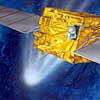
|
 |
|
Friday:
May 14, 2004 | |
0408 GMT |
 |
'Smoking gun' evidence of giant meteor collision
Evidence is mounting that 251 million years ago, long before the dinosaurs
dominated the Earth, a meteor the size of Mount Everest smashed into what is
now northern Australia, heaving rock halfway around the globe, triggering
mass volcanic eruptions, and wiping out all but about ten percent of the
species on the planet.
 FULL STORY FULL STORY
 |  |

|
 |
Latest Cassini image shows bands of clouds and lace
As Cassini nears its rendezvous with Saturn, new detail in the banded clouds of the planet's atmosphere are becoming visible. Cassini began the journey to the ringed world of Saturn nearly seven years ago and is now less than two months away from orbit insertion on June 30.
 FULL STORY FULL STORY
 |  |
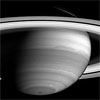
|
 |
IN OTHER NEWS Additional stories making news today
|
 |
Mars Exploration Rover updates -- The Mars rover Opportunity has spent the past several days exploring around the rim of Endurance Crater, giving scientists different views of the landscape. Meanwhile, Spirit has surpassed the one-mile mark on its odometer as the craft continues toward the Columbia Hills.
|
 |
NEWSWIRE Links to news across the internet
|
 |
Private manned rocket soars 211,400 feet -- (AP) A privately developed manned rocket soared to 211,400 feet over California on Thursday, marking the third and highest powered flight of the reusable launch vehicle, the builders said.

Florida Space Authority eyes X Prize -- (AP) The Florida Space Authority is ready to step back into the race to host the first privately funded manned space flight if New Mexico's winning plan falters, officials said.
|
 |
|
Thursday:
May 13, 2004 | |
0331 GMT |
 |
New launch added to this year's Atlas 5 schedule
Lockheed Martin's next-generation Atlas 5 rocket has received two orders this week -- both for commercial communications satellite launches -- including one that is slated to occur before year's end.
 FULL STORY FULL STORY
 |  |
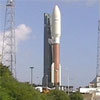
|
 |
Australian satellites to fly on Soyuz and Ariane 5
The inaugural flight of a Russian Soyuz rocket from South America will carry an Australian telecommunications satellite in a deal that also includes a sister spacecraft flying aboard an Ariane 5 booster, launch marketer Arianespace announced Wednesday.
 FULL STORY FULL STORY
 |  |
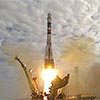
|
 |
IN OTHER NEWS Additional stories making news today
|
 |
International Space Station managers selected -- Two International Space Station managers are taking on new positions in the program. Michael Suffredini has been named ISS deputy program manager and Mark Geyer will replace Suffredini as mission operations integration manager for the ISS Program.

Talone receives presidential award for leadership -- NASA Kennedy Space Center's John J. "Tip" Talone Jr. was awarded the prestigious rank of Distinguished Executive in a ceremony on the grounds of the White House.
|
 |
NEWSWIRE Links to news across the internet
|
 |
New Zenit rocket engine successfully tested -- (RIA Novosti)
The new Sea Launch Zenit RD-171M rocket engine has successfully undergone its first test firing, a spokesman for the Energomash scientific-production association, Vladimir Sudakov, said at the ILA-2004 aerospace exhibition.
|
 |
|
Wednesday:
May 12, 2004 | |
0541 GMT |
 |
Boeing manager charged in trade secrets case
A former Boeing Company engineer was charged Tuesday in two separate conspiracies involving the theft of trade secrets from rival Lockheed Martin Corporation, which was competing with Boeing to secure an Air Force rocket contract.
 FULL STORY FULL STORY
 |  |

|
 |
Dying star sculpts rungs of gas and dust
A new image, taken with NASA's Hubble Space Telescope, reveals startling new details of one of the most unusual nebulae known in our Milky Way. Cataloged as HD 44179, this nebula is more commonly called the "Red Rectangle" because of its unique shape and color as seen with ground-based telescopes.
 FULL STORY FULL STORY
 |  |

|
 |
Spitzer shares the wealth
Like a philanthropist donating a prized collection to a museum, NASA's Spitzer Space Telescope has opened a virtual vault rich with scientific data. The Spitzer Science Archive now provides astronomers access to the infrared telescope's data well before the mission's one-year anniversary in space.
 FULL STORY FULL STORY
 |  |
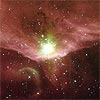
|
 |
|
Tuesday:
May 11, 2004 | |
0534 GMT |
 |
Giant galaxy's violent past comes into focus
Long-exposure images of the giant elliptical galaxy M87 by NASA's Chandra X-ray Observatory, together with radio observations, have provided spectacular evidence of repetitive outbursts from the vicinity of the galaxy's supermassive black hole. Magnetized rings, bubbles, plumes and jets ranging in size from a few thousand to a few hundred thousand light years point to ongoing violent activity for hundreds of millions of years.
 FULL STORY FULL STORY
 |  |
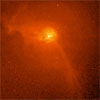
|
 |
XMM-Newton detects X-ray 'solar cycle' in distant star
For years, astronomers have wondered whether stars similar to the Sun go through periodic cycles of enhanced X-ray activity, like those often causing troubles to telephone and power lines here on Earth. Europe's X-ray observatory XMM-Newton has now revealed for the first time a cyclic behaviour in the X-ray radiation emitted by a star similar to the Sun.
 FULL STORY FULL STORY
 |  |
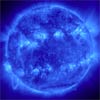
|
 |
NEWSWIRE Links to news across the internet
|
 |
New Bush space speech planned -- (United Press International) President George W. Bush plans to make a major speech early this summer defending his plan for a new U.S. space exploration initiative, administration sources told United Press International.

Russian says Mars mission is realistic -- (AP) Russia's new space agency chief said Monday that a manned mission to Mars in the near future is realistic provided funding is adequate, and appeared to express support for an ambitious plan to visit the planet within a decade, the Interfax news agency reported.
|
 |
IN OTHER NEWS Additional stories making news today
|
 |
NASA to name supercomputer after Columbia astronaut -- NASA will dedicate a new supercomputer this week to honor the memory of astronaut Kalpana "KC" Chawla, one of the seven crew members aboard the Space Shuttle Columbia, lost Feb. 1, 2003. The dedication ceremony will be held May 12 at NASA Ames Research Center, Moffett Field, Calif.

Gravity Probe B update -- Gravity Probe B - a NASA experiment to test two predictions of Albert Einstein's Theory of General Relativity - continues to perform well. Launched April 20 from Vandenberg Air Force Base, Calif., the spacecraft remains in its science mission orbit within the plane of its guide star, IM Pegasi, and program managers are expecting a smooth and successful transition into the science phase of the mission.
|
 |
|
Monday:
May 10, 2004 | |
0423 GMT |
 |
The Eventual Eleven: Meet the astronaut class of '04
They are the faces of the next era of U.S. space exploration. Selected by NASA as the 2004 class of astronaut candidates, these nine men and two women will wait years before getting the opportunity to fly into space. But their work will help prepare for humankind's return to the moon and push to Mars.
 FULL STORY FULL STORY
 |  |

|
 |



